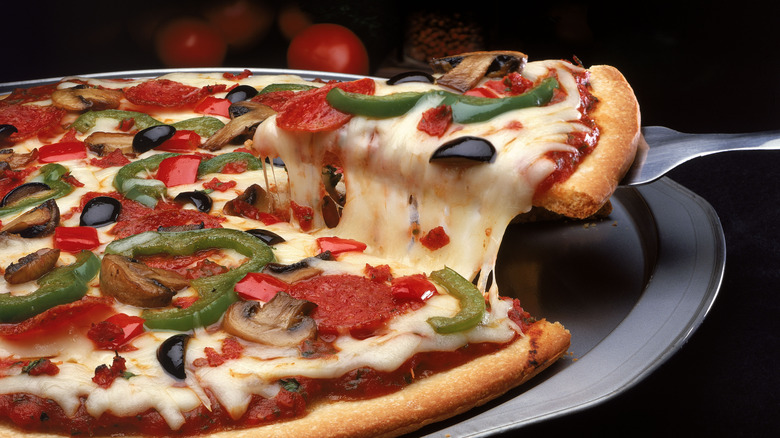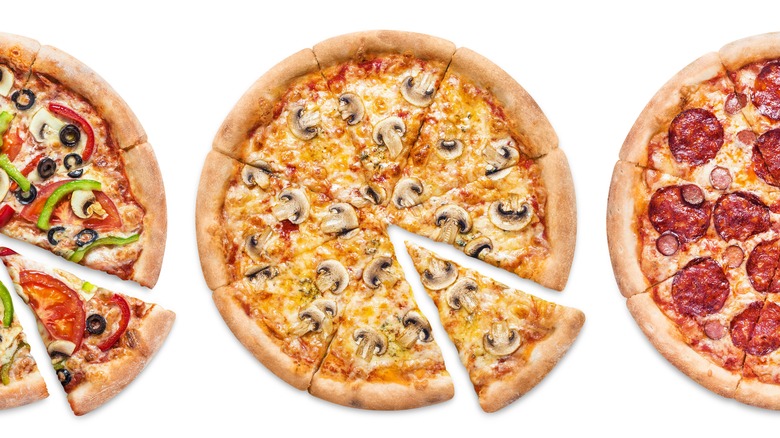The Difference Between Pizza And Flatbread Is All In The Dough
How many times have you gone out to eat and fielded the question "A buffalo chicken flatbread? That's just a pizza, right?" If you've spent any time at your local pub or late-night eatery, you've likely had your fair share of pizzas and flatbreads. Due to their similar structural nature, you may have also wondered what, if anything, differentiates the two from one another.
As the name of the dish may suggest, the key difference between a flatbread and a pizza rests in the very bread upon which the sauce, cheese, and optional extra toppings are stacked. Pizza dough is made with yeast, which provides a great deal of rise and chewiness to the crust, while flatbreads are typically made using an unleavened dough, with neither yeast nor other leavening ingredients such as baking soda or baking powder.
Though the terms have become somewhat synonymous with one another in recent years, and in many restaurants, flatbreads are actually made with pizza dough. There are a few other qualities that set flatbreads apart from pizzas. The shape of the dough — usually a rectangle or oval — distinguishes them from the familiar perfect circle of a pizza pie. They're often thought of as a side or appetizer, which means that the chef can experiment with more unusual toppings, especially as they don't have the time-honored expectations attached to certain flavors of pizza.
What does flatbread look like around the world?
There are many kinds of flatbread around the world, both the pizza variety and otherwise. Not all flatbreads are used as a base to stack pizza ingredients. Many cultures utilize flatbread as a means to build a wide array of dishes, including naan and paratha in India, tortillas in central and South America, injera in Ethiopia, pita in Greece and the middle east, and roti in many parts of the world. Flatbread production dates back to 8,500 BC in ancient Mesopotamia and was thought to have been made soon after milled flour was invented. Some flatbreads, such as those which are often seen as a base for pizza, even contain a small amount of yeast or other leavening, to give a slight amount of rise to the dough, and allow for a flexible pull-apart texture.
There are many reasons for the widespread popularity of flatbread. At its simplest, it's just milled grain and water, and this makes it both economical and practical. It's also easy to transport, and it can be made, in many cases, without an oven. It can also be used to hold food as a plate or bowl, as well as to get the food to your mouth, acting almost as a utensil, minimizing the need for excess equipment. And it's endlessly adaptable, and a great base for ingredients and other toppings, which leads us back to pizza.
What is a pizza, historically speaking?
Like flatbreads, pizza has a number of deeply rooted cultural origins, as well as a host of newfangled offshoots that have made the dish as ubiquitous as it is delicious. In fact, a recently unearthed fresco from Pompeii seems to depict something resembling a modern pizza, leading some historians to theorize that it has even earlier historical roots than previously believed. Pizza is generally accepted to have been invented in Naples, Italy sometime during the 18th century. Today, pizza frequently tops lists for the most popular dish around the globe. In the modern-day U.S., pizza can be found in a myriad of regional styles. Chicago, Detroit, and of course, New York City, have all brought a unique style and flavor. Pizza comes in a number of varieties including thin crust and deep dish, and nearly every kind uses a yeasted dough.
While flatbreads can most often be identified by their thin, flaky crust, pizza dough made with yeast creates a sturdier, more foldable base for your pie that doesn't snap when pressure is applied. Even pizzas with the thinnest crust tend to contain a great deal more heft than their yeast-less counterparts, which behave functionally more like crackers than bread. Despite the doughy distinctions between pizza and flatbreads, you can safely assume that if you like one dish, you'll probably like the other. So go ahead, take a plunge into the fascinating world of flatbread pizzas during your next social outing!


